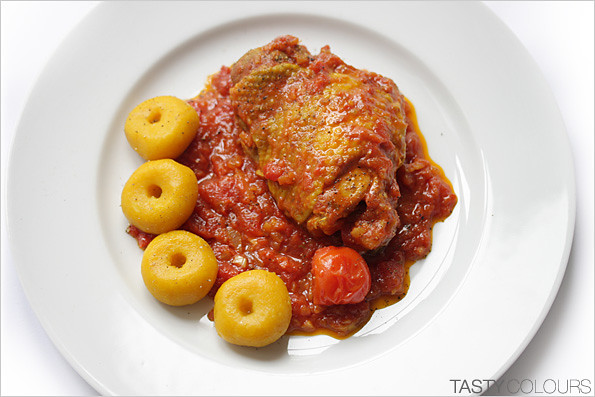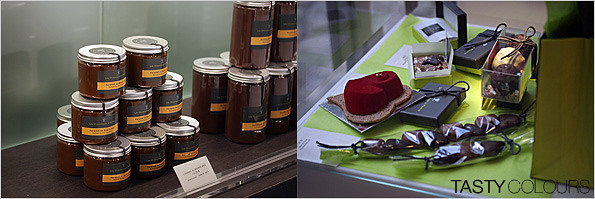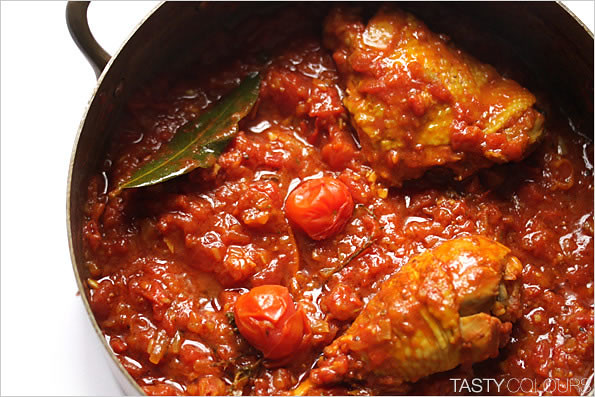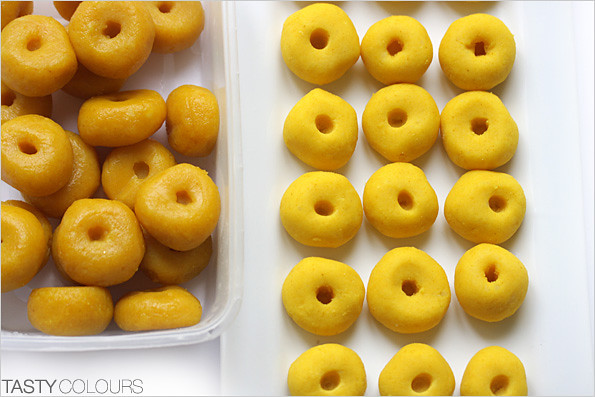
I have been having an irresistible will to eat citruses for around three weeks and I do not know why. In general, I do not eat raw fruits since 3-4 years; in particular, I am not so crazy about fresh citruses; of course in summer time I try, occasionally, seasonal fruits like, for example, strawberries, raspberries and bilberries. But on the other hand, I admire fruits in salads, especially when they are accompanied by some nice savory dressings. I like the mixture of fruits and meats, fruits and fish or vegetables, and I will not say “no” to dishes with fruit based sauces. I remember that a few years ago, when I was living in Strasbourg, I would drink a glass of juice from freshly squeezed citruses every morning. Basically I can live without fruits, any fruits. Only sometimes, once or twice a year, I have a fruit attack. And this time, I want to eat oranges, lemons and grapefruits; and I want to cook meats with orange flavored sauces. This explains why I present today this citrus-tomato braised chicken legs recipe. I served them with Polish style Silesian dumplings (“kluski śląskie”) into which I added powdered turmeric (curcuma).
Silesian dumplings are a kind of potato dumplings most popular in the southern region of Poland, Silesia. You will also find them in other parts of Poland. There exist two varieties of them. White dumplings, made from cooked potatoes and starch; and grey (or black) ones, made from a mixture of cooked and raw potatoes with the addition of flour. The dumplings are oval and have a small hole or depression in the center – ideal to pour a bit of extra sauce in there. Traditionally, they often are served as an accompaniment to meat and sauces and cooked red cabbage. In my family home, my mum used to make them as an accompaniment to our New Year’s Eve dinner – hunter’s style beef (“wołowina na dziko”). They also go very well with mushroom or vegetable sauces. As all dumpling and pasta food, they are appropriate for performing unlimited culinary experiments. You can add some fresh chopped green herbs, or some spices, like for example turmeric, which goes well with citruses and tomatoes. My husband does not like them because of their gluey texture – which is exactly what I like about them. In general I like food with gluey textures like cartilages, jellies, calamari, oysters, snails and so on, while does not like them at all (sometimes I doubt he’s French). Recipes for dumplings vary – some people use eggs, others – like me – do not. In general one should remember that the ratio between cooked potatoes and flour should be 4:1.
Citrus – Tomato Chicken with Silesian Dumplings with Turmeric (Curcuma)
Serves 4
Ingredients:
3 large chicken legs – around 1 kg (if the chicken skin is too thick and greasy, remove it and throw it away) cut into halves
1 lemon (preferably organic)
2 oranges (preferably organic)
2 small onions, peeled and finely chopped
1 tablespoon coriander seeds
6 cloves
A few colored pepper grains (or just black pepper grains)
2 large garlic cloves, peeled and finely chopped
2 cans (2x400 ml) good Italian cherry tomatoes (you may use other types of tomatoes)
1 ladle broth (preferably chicken)
3 red chilies
3-4 sprigs fresh thyme
1 leaf fresh bay leave
Salt
Pepper
Olive oil
Some honey, or brown sugar just in case your canned tomatoes or oranges are too sour – according to taste
1 In a mortar, mash cloves, coriander seeds and pepper grains. Pour the boiling water over oranges and lemon. Peel zest of ½ an orange and ½ of a lemon – remove the white parts which are bitter and cut the zest into very thin strips. Squeeze the juice out of the fruits and put aside. Rub the pieces of chicken with 2 tablespoons of olive oil, half the chopped garlic cloves and spices: cloves, coriander and pepper. Add orange and lemon zest. Pour lemon and orange juice and marinade for 1 hour, flipping occasionally.
2 In the meantime, heat 3-4 tablespoons of olive oil in a frying pan, add onions and remaining garlic and fry over medium heat, being aware not to burn them (around 10 minutes) and remove from heat.
3 Remove the meat from the marinade, removing spices and additions (do not throw them away of course). In a large (but not deep) roast pan, heat well 2 tablespoons of olive oil, and roast the meat on all sides until gold. Then reduce the heat. Add the marinade with all spices, cooked onions, tomatoes, chilies (I did not chop them because of my small daughter, but if you want a spicier taste, chop the chilies), thyme sprigs, bay leave and a ladle of broth. Braise over low heat around 45 minutes up to 1 hour, covered nearly completely (you have to check on the evaporation and thickening of the sauce). Should it be is too liquid, remove the lid and reduce the sauce for a couple of minutes over higher heat. Finally, season with salt and eventually with some more pepper, according to your taste.
4 Serve with Silesian dumplins (recipe below) or rice.
Variation on Kluski śląskie (Silesian dumplings)
Makes around 60 small dumplings
Ingredients:
1 kg potatoes (you should have around 760-800 grams after peeling them)
180 g potato starch
1 flat table spoon, powdered turmeric (curcuma) (if you do not like it, just omit this ingredient and you will have traditional Silesian white dumplings)
Salt
1 Peel potatoes and cook them in boiling water with the addition of some salt. Strain them and let cool down a bit. Add curcuma and mash potatoes while still quite warm until turmeric mixes equally and potatoes have a nice, deep yellow color. Put potato puree at the bottom of a bowl, flatten it and add potato starch and a pinch or two of salt. Work the dough with hands until the mixture becomes homogenous.
2 In a large saucepan bring water to a boil, add some salt. In the meantime, prepare dumplings. Should the potato puree had become completely cold, add one egg to the mixture and work the dough one more time. Take a bit of dough into your hand, roll a small bowl of about 1.5 cm, flatten it a bit and then make a depression with a thumb or a Chinese chopstick.
3 Cook dumplings in batches (of about 20 pieces each). Mix delicately, so they do not get stuck to each other. Once they float on top of the water, cook them for another 2-3 minutes maximum. Strain and serve hot with meat and sauces.
Polish version of the recipe - przepis w języku polskim:
Kurczak w sosie cytrusowo – pomidorowym
Składniki (4 osoby)
3 duże nogi kurczaka – ok 1 kg (jeśli skóra jest zbyt gruba i tłusta, zdjąć skórę), przekrojone na połówki
1 cytryna (w miarę możliwości ekologiczna)
2 pomarańcze (w miarę możliwości ekologiczne)
2 małe cebule, obrane i drobno posiekane
1 łyżka nasion kolendry
6 goździków
Kilka ziaren kolorowego pieprzu (może być czarny)
2 duże ząbki czosnku, obrane i drobno posiekane
2 puszki dobrych włoskich pomidorów koktajlowych w zalewie (ewentualnie innych)
1 chochla bulionu, najlepiej z kurczaka
3 czerwone papryczki chili
3-4 gałązki świeżego tymianku
1 świeży lub suszony liść laurowy
Miód, ewentualnie cukier trzcinowy albo melasa w przypadku, gdy pomidory okażą się zbyt kwaśne
sól
pieprz
oliwa
1 Utłucz w moździerzu ziarna goździków, kolendry i pieprzu. Pomarańcze i cytryny sparz wrzątkiem. Obierz skórkę w połowy jednej pomarańczy i cytryny (usuwając biały, gorzki miąższ). Pokrój na cienkie paseczki. Wyciśnij sok z owoców. Natrzyj mięso dwoma łyżkami oliwy, połową czosnku, przyprawami: goździkami, kolenrą i pieprzem. Dodaj skórkę pomarańczową i cytrynową. Zalej sokiem z cytrusów i marynuj przez godzinę, co jakiś czas obracając.
2 W międzyczasie obraną i posiekaną drobniutko cebulę, a także pozostały czosnek, usmaż na średnim ogniu na rozgrzanej patelni z dodatkiem 3-4 łyżek oliwy mieszając i uważając, aby się nie przypaliła (około 10 minut), po czym zdejmij z ognia.
3 Wyciągnij mięso z marynaty i oskrob je z przypraw oraz dodatków (nie wyrzucaj ich). Rozgrzej rondel z 2 łyżkami oliwy i na dużym ogniu obsmaż mięso równomiernie ze wszystkim stron. Zmniejsz ogień. Dodaj marynatę z przyprawami, skórkami cytrusów i czosnkiem, uduszoną cebulę, pomidory w zalewie, papryczki chili (nie siekałam, bo ze względu na dziecko nie chciałam, aby było ostre), tymianek, liść laurowy i bulion. Duś na wolnym ogniu pod przykryciem około 45 minut do godziny pod niepełnym przykryciem, tak aby nadmiar płynu odparował i zrobił się gęstawy (trzeba sprawdzać). Jeżeli mimo to sos jest zbyt rzadki, trzeba go odparować na dość wysokim ogniu. Na koniec doprawić solą i ewentualnie pieprzem. Nie musiałam dodawać cukru, miodu czy melasy, bo akurat sok z pomarańczy był bardzo słodki, a na dodatek trafiły mi się dobrej jakości pomidorki w zalewie.
4 Podawać z ryżem lub kluskami.
Kluski śląskie z kurkumą
(około 60 małych klusek)
Składniki:
1 kg ziemniaków (po obraniu około 760 – 800 g)
180 g skrobii ziemniaczanej
1 płaska łyżka stołowa kurkumy
sól
1 Obierz i umyj ziemniaki. W garnku zagotuj wodę, posól ją. Dodaj ziemniaki i ugotuj do miękkości, a następnie odcedź i trochę ostudź. Dodaj kurkumę i ieszcze bardzo ciepłe utłucz je dokładnie tłuczkiem na jednolitą masę do momentu, aż przyprawa ładnie się połączy z ziemniakami. Następnie dodaj skrobię i szczyptę – dwie soli i wyrób na jednolite ciasto (około 5 minut).
2 W dużym garnku zagotuj wodę z dodatkiem soli.
3 W międzyczasie zrób kluski, formując z kawałków ciasta kulki o średnicy ok. 1,5 cm, spłaszczając ją nieco i robiąc wgłębienie palcem lub chińską pałeczką. Gotuj kluski w osolonej wodzie (ja gotuję w partiach po około 20 klusek). Delikatnie mieszaj. Gotuj około 2-3 minut od momentu wypłynięcia na powierzchnię. Wybierz łyżką cedzakową i serwuj gorące razem z mięsem.















